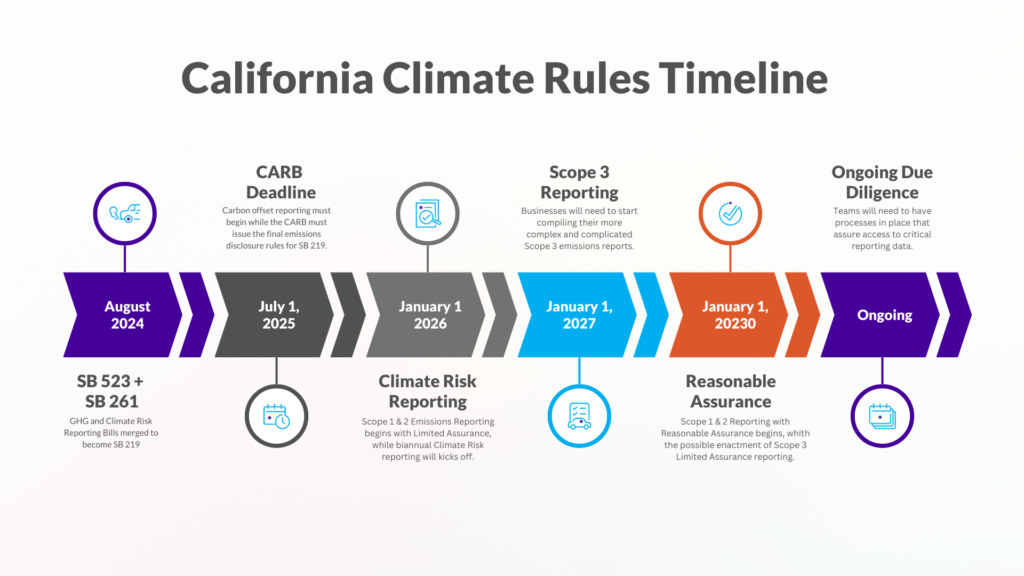It’s no secret that many federally-backed enterprise sustainability initiatives have been paused—if not shelved entirely—in recent months. However, state legislators across the U.S. have been picking up the slack and pushing forward on local measures aimed at having a global impact where environmental reporting is concerned.
Case in point is California’s Senate Bill 219 (SB 219), which will require roughly 10,000 companies doing business in the state to begin disclosing their full greenhouse gas (GHG) emissions beginning in 2026.
While this is a local mandate on its face, the implications are wide-reaching, given the scope of California’s economy, the threshold for eligibility, and the breadth of the reporting requirements.
For instance, the new senate bill requires “accurate calculations for Scope 1, 2 and 3 emissions” as defined by the Greenhouse Gas Protocol Corporate Accounting and Reporting Standard and the Greenhouse Gas Protocol Corporate Value Chain (Scope 3) Accounting and Reporting Standard, which dig deep into supply chains and dictate a wide reporting footprint.
Additionally, the new rules apply to any organizations conducting business in the state with revenue exceeding $500 million annually.
When considering the Direct, Indirect, Upstream and Downstream emissions that fall under this mandate, these new measures will put pressure on a wide range of global enterprises to keep sustainability a priority.
This will also push decision makers to explore systems and workflows that not only encourage more sustainable practices but grant insights into emissions that business leaders can bring back to regulatory bodies.
In this blog, we’ll unpack the details of SB 219 and steps your company can take to better position themselves for compliance in the leadup to 2026. This includes getting visibility into what is likely a major source of corporate emissions—your driving employee workforce—to gain access to the data you need and take actionable steps that minimize your business’ climate risk.
What is CA SB 219?
Passed in September 2024, SB 219 combines and consolidates previously-pitched SB 253—the state mandate for GHG emissions reporting—and SB 261—a more nuanced Climate Risk Reporting measure.
The new rules passed in September grant the California Air Resources Board (CARB) an extension to further define reporting rules by July 1, 2025, while keeping intact the revenue threshold and “reach” of the mandate across supply chains (ie. Beyond just California).
While SB 219 also removed the filing fee previously required under SB 253 and 261, many of the key mandates of both original bills were approved with SB 219’s passing.
The GHG Emissions Reporting Requirements
Along with conducting business in California—which includes any company with financial transactions, headquarters or significant operations in the state—organizations that will be required to take part in the GHG Emissions-specific reporting will only be those with $1billion USD in revenue as of 2025 (roughly 5,400 companies in total).
The timelines for reporting as of September are:
- For Scope 1 & 2 GHG Emissions: Starting in 2026, companies must publicly report their Scope 1 (Direct emissions) and Scope 2 (Indirect emissions) based on 2025 data.
- For Scope 3 GHG Emissions: Beginning in 2027, companies must also report their Scope 3 emissions (Indirect emissions from the entire value chain) based on 2026 data.
Originally, SB 253 dictated that companies had 180 days after reporting Scope 1 and 2 emissions to submit Scope 3. SB 219 gave CARB license to determine the Scope 3 reporting timeline beginning in 2027, giving companies a bit more lead time to address and understand their more complicated Scope 3 emissions data.
Businesses must also have their GHG emissions data audited by a third-party, with Limited Assurance required for Scope 1 and 2 data beginning in 2026. For Scope 3, Limited Assurance must be acquired by 2030—the same year that businesses will need to start providing Reasonable Assurance for Scope 1 and 2 data.
Businesses that don’t comply with SB 219 GHG Emissions Reporting standards could see annual fines of up to $500,000. There is, however, some leeway for Scope 3:
- No penalties will be imposed for inaccuracies in Scope 3 emissions reporting, provided that the statements were made on a reasonable basis and in good faith.
- Between 2027 and 2030, penalties related to Scope 3 emissions will only apply to cases of non-submission.
The Climate Risk Reporting Requirements
While Climate Risk Reporting under SB 219 applies to a wider swath of business—the estimated 10,000+ that meet the $500 million revenue threshold—qualifying companies must only prepare and submit this data every two years.
To comply, businesses must follow the Task Force on Climate-related Financial Disclosures (TCFD) framework, which has been around since 2015 and (fortunately) many businesses are already following today. With a strong focus on governance, strategy, risk management and goal setting, Climate Risk Reports under SB 219 must:
- Disclose potential climate-related financial risks under the TCFD model
- Report on specific actions and strategies the business is taking to mitigate those risks
- Publish the climate risk report publicly on the company’s website
- Submit a formal statement to the California Secretary of State confirming that the disclosure has been completed
- Ensure the report is substantive and complete
- Prepare for third-party review by a nonprofit climate disclosure organization (defined by CARB) to evaluate for completeness and quality, and to analyze systemic and sector-specific risks
Under SB 219, penalties for companies that fail to publish climate risk reports or insufficient reports can top $50,000 per reporting year, though previous compliance efforts and good faith will be considered by assessors.
Timeline and Getting Started
While CARB’s deadline to finalize disclosure rules wraps on July 1, 2025, businesses will only have about six months from there before new measures are expected to go into effect and reporting will commence.
Considering very few of the overarching requirements are expected to be modified following the latest deadline, there’s no time to waste in establishing better systems to capture data and reduce climate risk full-stop.

Five Essential Steps for SB 219 Compliance
-
Establish Robust ESG Data Governance
Effective data governance is the foundation of SB 219 compliance. Starting in 2025, you’ll need:
- Defined responsibility structure: Designate specific team members to collect data from different departments and establish a cross-functional team that meets regularly to review reporting processes.
- Centralized data repository: Create a single location for all emissions data, documentation, and metadata to simplify audit procedures.
- Quality control processes: Implement standardized collection methods and templates to ensure consistency, with both internal and external validation.
- Supplier data systems: Begin coordinating with suppliers to align their data with your Scope 3 reporting needs.
-
Focus Initially on Scope 1 and 2 Emissions
Your first compliance deadline requires only Scope 1 and 2 emissions reporting:
- Scope 1: Emissions from company-owned or controlled sources (facilities, vehicles)
- Scope 2: Indirect emissions from purchased electricity, steam, heat, or cooling
Most organizations already track this information but need to centralize and verify it for reporting purposes. This includes gaining as much access to detailed driver emissions data, for instance, to get a complete picture of how your employees who drive for work, for instance, may be driving up your Scope 1 measures.
-
Adopt the TCFD Framework
Climate risk reporting under SB 219 aligns with the Task Force on Climate-related Financial Disclosures (TCFD) framework. Focus on its four pillars:
- Governance
- Strategy
- Risk management
- Metrics and targets
SB 219 follows a “report or explain” approach, requiring disclosure of available information and explanations for any gaps.
-
Start Supplier Engagement Early
While Scope 3 reporting doesn’t begin until 2027, early supplier engagement is crucial. Begin requesting emissions and risk data from suppliers now to ensure they’re prepared to provide what you’ll need for compliance.
-
Prepare for Assurance Requirements
From the first reporting year, companies must obtain limited assurance for Scope 1 and 2 emissions. This makes strong data governance essential, with well-organized, accurate data that auditors can easily access. Consider conducting a pre-audit check before compliance deadlines.
Special Considerations for Businesses with Driving Employees
For businesses with driving employees, SB 219 presents unique challenges and opportunities. After all, measures like SB 219 could be the impetus that many organizations need to get out of the traditional fleet or “company car” model full-stop.
Instead, businesses can explore vehicle reimbursement strategies that allow employees to use their personal vehicles for work travel. By switching up this ownership paradigm, you can help limit the corporate Scope 1 GHG footprint for your businesses, while potentially giving your employees license to choose more efficient vehicles.
Enhanced Focus on Fleet Emissions
Your vehicle fleet likely represents a significant portion of your Scope 1 emissions. Whether you move away from the traditional legacy fleet model for a vehicle reimbursement strategy or not, you still must implement detailed tracking of:
- Fuel consumption by vehicle type
- Mileage records for company vehicles
- Maintenance records that could affect emissions performance
Employee Travel Considerations
For businesses with driving employees using personal vehicles, develop systems to track:
- Business mileage in personal vehicles (typically falls under Scope 3)
- Reimbursement records that can help quantify emissions
- Trip purpose categorization for more detailed reporting
EV or Hybrid Vehicle Planning
SB 219 compliance offers an opportunity to evaluate fleet electrification:
- Document emissions reduction potential from fleet transitions
- Calculate ROI on electric vehicle investments
- Develop a roadmap for gradual fleet modernization
Telematics Integration
Consider implementing or expanding telematics solutions to:
- Automatically collect emissions-relevant data
- Identify inefficient routes or driving behaviors
- Generate reports that can directly feed into your emissions calculations
By addressing these transportation-specific elements alongside the core compliance steps, businesses with vehicle fleets can turn SB 219 compliance into an opportunity for operational improvement and cost reduction.
To learn more about how Motus can help your team capture the emissions data you need to report on your driving workforce on improve operations, talk to one of our experts today.







